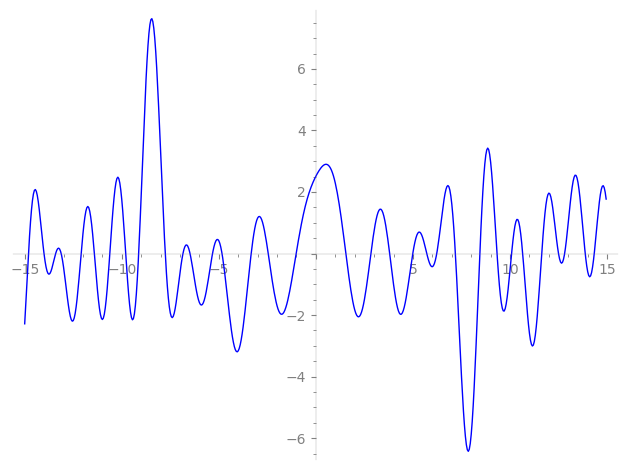| L(s) = 1 | + 2-s + (−0.707 − 0.707i)3-s + 4-s + (2.22 + 0.215i)5-s + (−0.707 − 0.707i)6-s + (−1.35 − 1.35i)7-s + 8-s + 1.00i·9-s + (2.22 + 0.215i)10-s + 0.0194i·11-s + (−0.707 − 0.707i)12-s − 0.159·13-s + (−1.35 − 1.35i)14-s + (−1.42 − 1.72i)15-s + 16-s − 4.04i·17-s + ⋯ |
| L(s) = 1 | + 0.707·2-s + (−0.408 − 0.408i)3-s + 0.5·4-s + (0.995 + 0.0961i)5-s + (−0.288 − 0.288i)6-s + (−0.512 − 0.512i)7-s + 0.353·8-s + 0.333i·9-s + (0.703 + 0.0679i)10-s + 0.00585i·11-s + (−0.204 − 0.204i)12-s − 0.0441·13-s + (−0.362 − 0.362i)14-s + (−0.367 − 0.445i)15-s + 0.250·16-s − 0.979i·17-s + ⋯ |
\[\begin{aligned}\Lambda(s)=\mathstrut & 1110 ^{s/2} \, \Gamma_{\C}(s) \, L(s)\cr =\mathstrut & (0.609 + 0.792i)\, \overline{\Lambda}(2-s) \end{aligned}\]
\[\begin{aligned}\Lambda(s)=\mathstrut & 1110 ^{s/2} \, \Gamma_{\C}(s+1/2) \, L(s)\cr =\mathstrut & (0.609 + 0.792i)\, \overline{\Lambda}(1-s) \end{aligned}\]
Particular Values
| \(L(1)\) |
\(\approx\) |
\(2.514948715\) |
| \(L(\frac12)\) |
\(\approx\) |
\(2.514948715\) |
| \(L(\frac{3}{2})\) |
|
not available |
| \(L(1)\) |
|
not available |
\(L(s) = \displaystyle \prod_{p} F_p(p^{-s})^{-1} \)
| $p$ | $F_p(T)$ |
|---|
| bad | 2 | \( 1 - T \) |
| 3 | \( 1 + (0.707 + 0.707i)T \) |
| 5 | \( 1 + (-2.22 - 0.215i)T \) |
| 37 | \( 1 + (5.84 - 1.68i)T \) |
| good | 7 | \( 1 + (1.35 + 1.35i)T + 7iT^{2} \) |
| 11 | \( 1 - 0.0194iT - 11T^{2} \) |
| 13 | \( 1 + 0.159T + 13T^{2} \) |
| 17 | \( 1 + 4.04iT - 17T^{2} \) |
| 19 | \( 1 + (-4.58 + 4.58i)T - 19iT^{2} \) |
| 23 | \( 1 - 2.53T + 23T^{2} \) |
| 29 | \( 1 + (-0.812 - 0.812i)T + 29iT^{2} \) |
| 31 | \( 1 + (-2.35 + 2.35i)T - 31iT^{2} \) |
| 41 | \( 1 - 8.21iT - 41T^{2} \) |
| 43 | \( 1 - 4.36T + 43T^{2} \) |
| 47 | \( 1 + (5.16 + 5.16i)T + 47iT^{2} \) |
| 53 | \( 1 + (4.20 - 4.20i)T - 53iT^{2} \) |
| 59 | \( 1 + (-3.16 + 3.16i)T - 59iT^{2} \) |
| 61 | \( 1 + (-1.82 + 1.82i)T - 61iT^{2} \) |
| 67 | \( 1 + (-2.18 + 2.18i)T - 67iT^{2} \) |
| 71 | \( 1 - 4.70T + 71T^{2} \) |
| 73 | \( 1 + (5.46 + 5.46i)T + 73iT^{2} \) |
| 79 | \( 1 + (4.93 - 4.93i)T - 79iT^{2} \) |
| 83 | \( 1 + (-6.36 + 6.36i)T - 83iT^{2} \) |
| 89 | \( 1 + (-10.2 - 10.2i)T + 89iT^{2} \) |
| 97 | \( 1 - 17.8iT - 97T^{2} \) |
| show more | |
| show less | |
\(L(s) = \displaystyle\prod_p \ \prod_{j=1}^{2} (1 - \alpha_{j,p}\, p^{-s})^{-1}\)
Imaginary part of the first few zeros on the critical line
−9.796773138714701888667030663268, −9.129441132783974747538503128315, −7.75860610942374200949709176679, −6.84709805460481937006610201306, −6.48416527737251683190725041898, −5.32427501340695701004172879714, −4.83647193547923394569818173977, −3.33352763782891122992521094409, −2.45566717222239092917850805910, −1.01643617757146017590237901787,
1.54346379619146293974796248339, 2.83289488444137300289019588842, 3.79896975805041275235433831277, 4.99040733030442994141838711583, 5.71085472370388452682003612486, 6.22401871782626195797069258810, 7.18357711097956370468009428232, 8.444292475679706453314049134227, 9.329952036533425668241875627478, 10.07988095302825838776461461941

